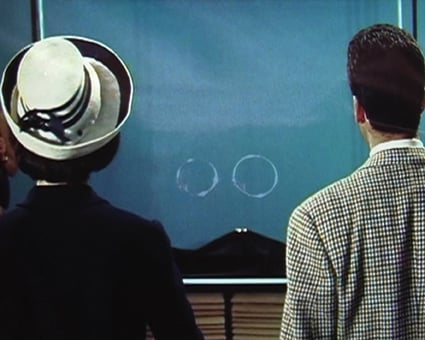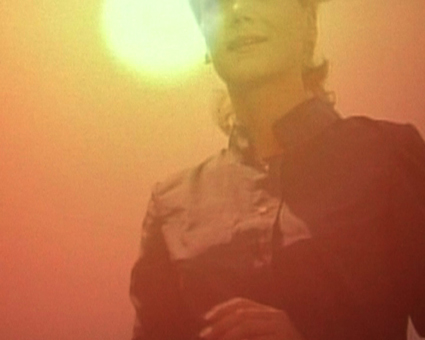Tarahi IV
2012 - Film & Video (Film & Video)
7’36’’min
Haris Epaminonda
Haris Epaminonda’s work questions the manipulation and the flow of images as well as their power of fascination. The images she works with to create her collages (paper or video) come from magazines or history books, film extracts or soap operas from the 1960s and 1970s. By readapting a universal past (in her work on monuments) as well as personal (with tv series she used to watch as a child, etc.) Haris Epaminonda questions the creation and the assertion of an identity in a particular cultural context and in a currently divided country. Created from extracts of kitsch movies or Greek soap operas from the 1960s, these videos are like audiovisual ‘postcards’ reflecting a nostalgic and melancholic approach. The images have lost their context and original meaning to then be re-assembled, confronted to each other and superimposed with other elements, to reveal new sequences. The narration has disappeared from the sequences and the spectator waits in vain for something to happen. In “Tarahi V”, the saturated colors of the sequences collected from 1960 films seem to give a new life to the characters (the little girl in pink with her doll, the couple walking backwards, etc.) while the fireworks, superimposed throughout the film provide a disenchanting aspect to the whole scene. Recalling Hitchcock as well as René Magritte, “Tarahi V” presents a pending moment providing the shots and the characters with ghostly appearances. This feeling is reinforced by the piano arrangement creating tension throughout the whole sequence. The lighting, the colors and the particular rhythm of Haris Epaminonda’s films provide a strong radiant power. They are like traces of a fictionalized past permanently stuck in one’s memory. Haris Epaminonda’s films and collages belong to a fragmented art that questions the “in between”, a shifting moment leading to a new spatial and time-related sphere.
Epaminonda’s video works are based on re-shot excerpts of film and television footage – principally the Greek soap operas and kitsch romantic films fromthe 1960s that used to fill up Sunday afternoons in the artist’s Cypriot childhood –which she then subtly reworks. Sometimes local celebrities appear in her films, but, in contrast to the early works of Francesco Vezzoli or T.J. Wilcox, they don’t do so in order to emphasize a phantasmal communion with their constructed identities. The scenes that she chooses to work with are not instantly recognizable from the original narrative, so the culled images are effectively stripped of their initial meaning and context. These out-takes are then edited and adapted in a variety of ways: the film’s speed and direction are changed, sections are distorted, its colour is intensified, or a poignant soundtrack is added. Most significantly, she also superimposes footage to make surreal composites: an indoor scene, say, might also have traces of fireworks glimmering through it. While these are all common manipulation techniques of digital video, Epaminonda uses them with captivating sensibility. Extract by Dominic Eichler (Frieze 111). Haris Epaminonda was born in Cyprus in 1980. She lives and works in Berlin, Germany.
Colors:
Related works of genres: » video artists
» see more

© » KADIST
Joachim Koester
2006Physical and mental exploration have been founding elements in Joachim Koester’s research for several years...

© » KADIST
Sebastián Díaz Morales
2014In Suspension a young man is hanging in the air, falling, or perhaps drifting through time and space...

© » KADIST
Walid Raad
2022For his first NFT release artist Walid Raad made a series of animated birthday cakes, titled Festival of Gratitude , for some of the world’s most toxic and larger-than-life leaders...
Other related works, blended automatically
» see more

© » KADIST
Haris Epaminonda
2007Created from extracts of kitsch movies or Greek soap operas from the 1960s, these videos are like audiovisual ‘postcards’ reflecting a nostalgic and melancholic approach...
Related works sharing similar palette
» see more

© » KQED
Inquiring Minds Want to Know: ‘How Does Santa Go Down the Chimney?’ | KQED Skip to Nav Skip to Main Skip to Footer The Do List Inquiring Minds Want to Know: ‘How Does Santa Go Down the Chimney?’ Listen Samantha Balaban Dec 4 Save Article Save Article Failed to save article Please try again Facebook Share-FB Twitter Share-Twitter Email Share-Email Copy Link Copy Link ‘How Does Santa Go Down the Chimney?’ (Text © 2023 by Mac Barnett...

© » KADIST
Saâdane Afif
2005In this work, Saâdane Afif quotes André Cadere’s round wooden batons using the copy share and remix principles...
Other works by: » Haris Epaminonda
» see more

© » KADIST
Haris Epaminonda
2007Created from extracts of kitsch movies or Greek soap operas from the 1960s, these videos are like audiovisual ‘postcards’ reflecting a nostalgic and melancholic approach...

© » KADIST
Haris Epaminonda
2007Haris Epaminonda’s work questions the manipulation and the flow of images as well as their power of fascination...
Related artist(s) to: Haris Epaminonda » Daniel Gustav Cramer, » Berlin Biennale, » Lara Favaretto, » Malmö Konsthall, » Maria Papadimitriou, » Olivia Plender, » Point Centre, » Abu Dhabi, » Adrian Paci, » Agnes Janich
» see more

© » KADIST
Daniel Gustav Cramer
2020David Gustav Cramer’s are composed of simple, descriptive texts accompanied by found photographs, letters or other materials...
Related works found in the same semantic group
» see more

© » KADIST
Anthony Discenza
2010A Viewing (The Effect) by Anthony Discenza is a continuous voiceover loop intended for presentation in a dedicated, light-and-acoustically controlled space...

© » KADIST
Douglas Gordon
1996In Monster (1996-97), the artist’s face becomes grotesque through the application of strips of transparent adhesive tape, typical of Gordon’s performance-based films that often depict his own body in action...

© » KADIST
Dennis Adams
2004The video Make down is a 34 minute sequence shot that shows the artist removing make-up in front of a mirror...




